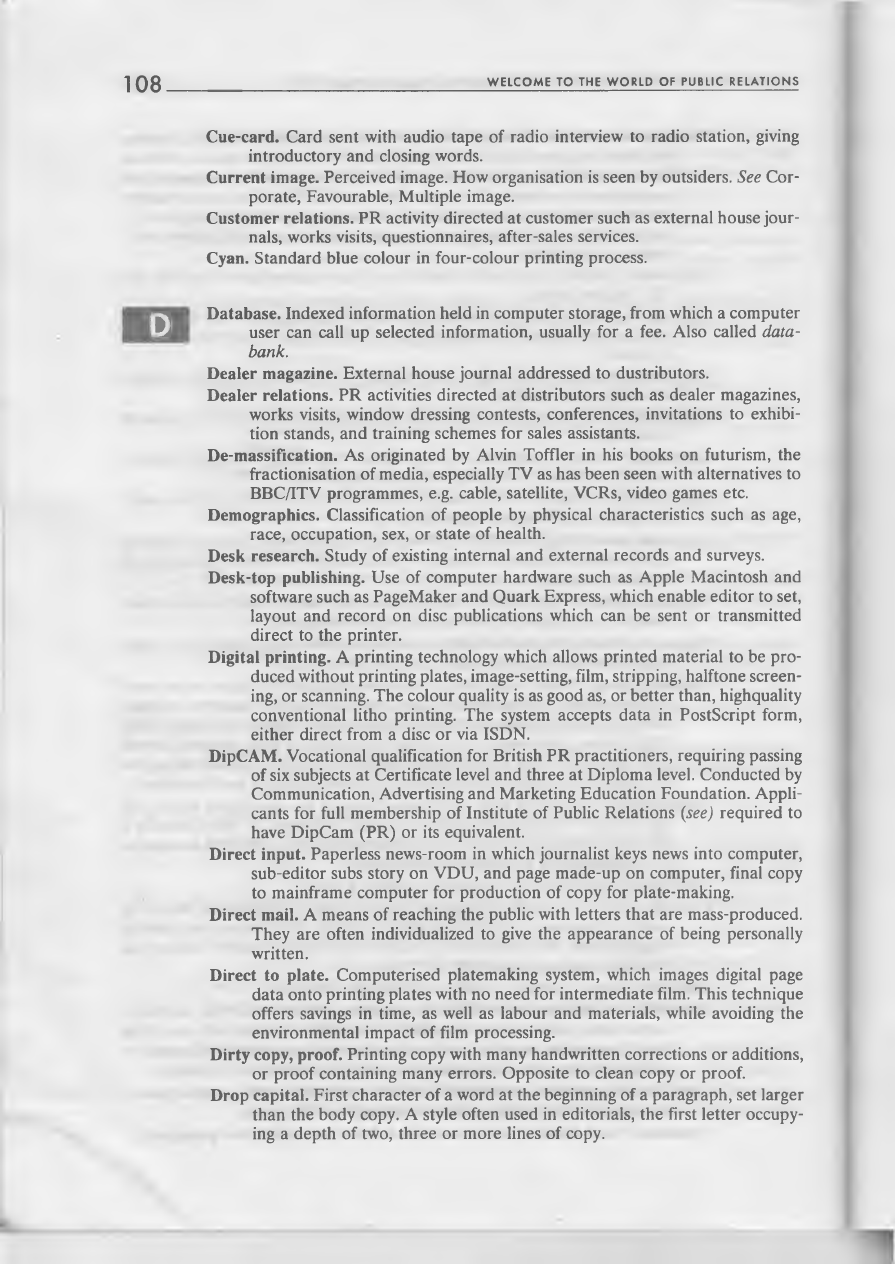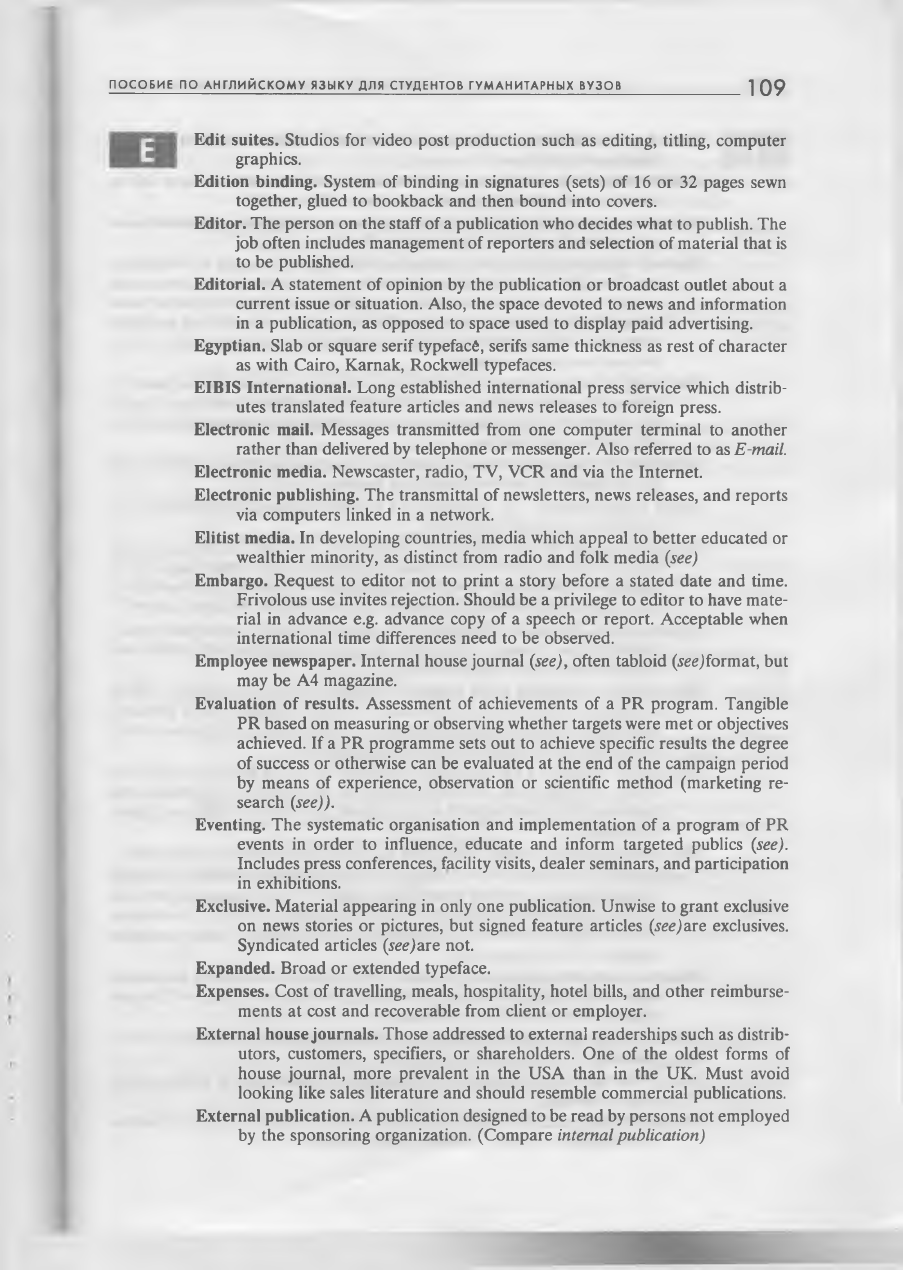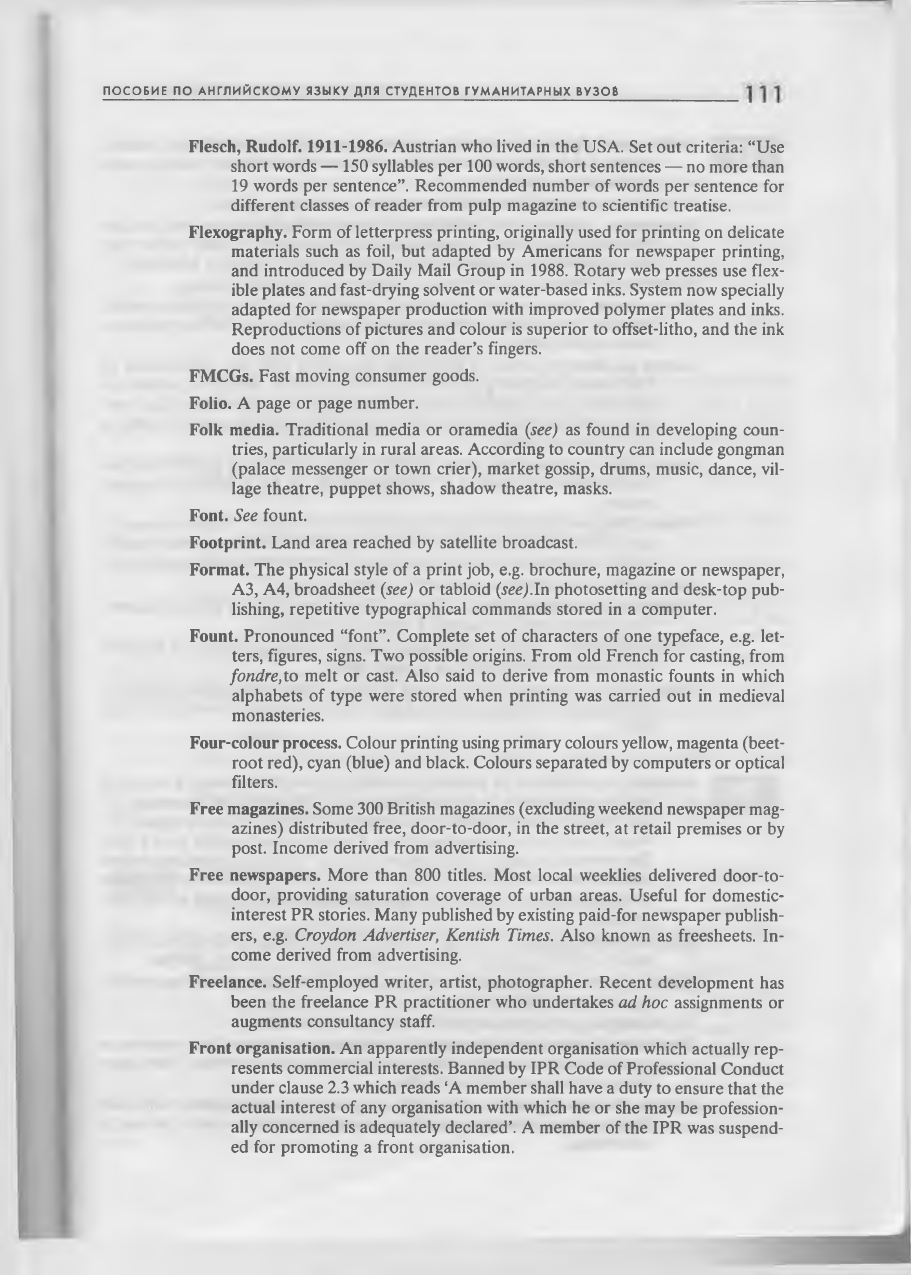ВУЗ: Не указан
Категория: Не указан
Дисциплина: Не указана
Добавлен: 01.04.2021
Просмотров: 1567
Скачиваний: 7

108
W E L C O M E T O THE W O R L D O F PUBLI C R E L A T I O N S
Cue-card. Card sent with audio tape of radio interview to radio station, giving
introductory and closing words.
Current image. Perceived image. How organisation is seen by outsiders.
See
Cor
porate, Favourable, Multiple image.
Customer relations. PR activity directed at customer such as external house jour
nals, works visits, questionnaires, after-sales services.
Cyan. Standard blue colour in four-colour printing process.
D
Database. Indexed information held in computer storage, from which a computer
user can call up selected information, usually for a fee. Also called
data
bank.
Dealer magazine. External house journal addressed to dustributors.
Dealer relations. PR activities directed at distributors such as dealer magazines,
works visits, window dressing contests, conferences, invitations to exhibi
tion stands, and training schemes for sales assistants.
De-massification. As originated by Alvin Toffler in his books on futurism, the
fractionisation of media, especially TV as has been seen with alternatives to
BBC/ITV programmes, e.g. cable, satellite, VCRs, video games etc.
Demographics. Classification of people by physical characteristics such as age,
race, occupation, sex, or state of health.
Desk research. Study of existing internal and external records and surveys.
Desk-top publishing. Use of computer hardware such as Apple Macintosh and
software such as PageMaker and Quark Express, which enable editor to set,
layout and record on disc publications which can be sent or transmitted
direct to the printer.
Digital printing. A printing technology which allows printed material to be pro
duced without printing plates, image-setting, film, stripping, halftone screen
ing, or scanning. The colour quality is as good as, or better than, highquality
conventional litho printing. The system accepts data in PostScript form,
either direct from a disc or via ISDN.
DipCAM. Vocational qualification for British PR practitioners, requiring passing
of six subjects at Certificate level and three at Diploma level. Conducted by
Communication, Advertising and Marketing Education Foundation. Appli
cants for full membership of Institute of Public Relations
(see)
required to
have DipCam (PR) or its equivalent.
Direct input. Paperless news-room in which journalist keys news into computer,
sub-editor subs story on VDU, and page made-up on computer, final copy
to mainframe computer for production of copy for plate-making.
Direct mail. A means of reaching the public with letters that are mass-produced.
They are often individualized to give the appearance of being personally
written.
Direct to plate. Computerised platemaking system, which images digital page
data onto printing plates with no need for intermediate film. This technique
offers savings in time, as well as labour and materials, while avoiding the
environmental impact of film processing.
Dirty copy, proof. Printing copy with many handwritten corrections or additions,
or proof containing many errors. Opposite to clean copy or proof.
Drop capital. First character of a word at the beginning of a paragraph, set larger
than the body copy. A style often used in editorials, the first letter occupy
ing a depth of two, three or more lines of copy.

П О С О Б И Е П О А Н Г Л И Й С К О М У Я З Ы К У Д Л Я С Т У Д Е Н Т О В Г У М А Н И Т А Р Н Ы Х В У З О В
109
E
Edit suites. Studios for video post production such as editing, titling, computer
graphics.
Edition binding. System of binding in signatures (sets) of 16 or 32 pages sewn
together, glued to bookback and then bound into covers.
Editor. The person on the staff of a publication who decides what to publish. The
job often includes management of reporters and selection of material that is
to be published.
Editorial. A statement of opinion by the publication or broadcast outlet about a
current issue or situation. Also, the space devoted to news and information
in a publication, as opposed to space used to display paid advertising.
Egyptian. Slab or square serif typeface, serifs same thickness as rest of character
as with Cairo, Karnak, Rockwell typefaces.
EIBIS International. Long established international press service which distrib
utes translated feature articles and news releases to foreign press.
Electronic mail. Messages transmitted from one computer terminal to another
rather than delivered by telephone or messenger. Also referred to as
E-mail.
Electronic media. Newscaster, radio, TV, VCR and via the Internet.
Electronic publishing. The transmittal of newsletters, news releases, and reports
via computers linked in a network.
Elitist media. In developing countries, media which appeal to better educated or
wealthier minority, as distinct from radio and folk media
(see)
Embargo. Request to editor not to print a story before a stated date and time.
Frivolous use invites rejection. Should be a privilege to editor to have mate
rial in advance e.g. advance copy of a speech or report. Acceptable when
international time differences need to be observed.
Employee newspaper. Internal house journal
(see),
often tabloid (seejformat, but
may be A4 magazine.
Evaluation of results. Assessment of achievements of a PR program. Tangible
PR based on measuring or observing whether targets were met or objectives
achieved. If a PR programme sets out to achieve specific results the degree
of success or otherwise can be evaluated at the end of the campaign period
by means of experience, observation or scientific method (marketing re
search
(see)).
Eventing. The systematic organisation and implementation of a program of PR
events in order to influence, educate and inform targeted publics
(see).
Includes press conferences, facility visits, dealer seminars, and participation
in exhibitions.
Exclusive. Material appearing in only one publication. Unwise to grant exclusive
on news stories or pictures, but signed feature articles
(see
)are exclusives.
Syndicated articles
(see
)are not.
Expanded. Broad or extended typeface.
Expenses. Cost of travelling, meals, hospitality, hotel bills, and other reimburse
ments at cost and recoverable from client or employer.
External house journals. Those addressed to external readerships such as distrib
utors, customers, specifiers, or shareholders. One of the oldest forms of
house journal, more prevalent in the USA than in the UK. Must avoid
looking like sales literature and should resemble commercial publications.
External publication. A publication designed to be read by persons not employed
by the sponsoring organization. (Compare
internal publication)

10
W E L C O M E TO THE W O R L D O F PUBLI C R E L A T I O N S
F
Face. A particular design of printing type of which there are several hundred
display and text faces.
Facility visit. A PR visit when journalists are invited or taken to make a visit in
order to write a story or prepare a radio or TV program.
Facsimile. Electronic method of transmitting exact reproductions of printed mat
ter over telephone lines. Commonly called
fax.
Facsimile machine. Device for sending reproduction of message by telephone
line. Two-Ten Communications have a special fax news service, but unless
invited to do so it can be unwise to make general distribution of news
releases by fax as this involves publisher paying for unsolicited material.
Newspapers using contract printers (e.g.
The Independent
jmay edit in Lon
don and fax pages to printers.
Fact sheet. A written summary about some event or situation that is given to
reporters so that they will have the basic facts at their fingertips. Often a
fact sheet will give information in the journalistic format of
who, what,
when, where, why,
and
how.
Facts book. Collection of contact reports
(see
) . Very useful when compiling end-
of-year report on services conducted for client.
Family (typographical). All variations of a typeface such as light, medium, bold,
condensed, expanded and italic.
Favourable image. An unfortunate but common PR term since an image can only
be as perceived. Implication is that an organisation with a bad image can be
given a favourable one, but a good image has to be deserved and depends on
knowledge and understanding.
See
Corporate, Current, Multiple image.
Feature article. Press item with greater substance than a news report and usually
bearing author’s name. A PR article should be negotiated with editor, and
written to suit editor’s instructions.
Feature story. A message giving detailed information about some subject such as
a company, an association, a product, a service, a situation, or a problem,
the objective of which is to educate and entertain readers. The focus is often
on human interest instead of late-breaking news.
Fee. Remuneration of a PR consultant, usually based on an hourly or daily rate
which represents time, overheads and profit, but exclusive of materials and
expenses. Not to be confused with a retainer
(see)
which usually only given
exclusivity.
Film. Motion picture footage, often used to convey information to audiences.
Financial PR. Specialised field of PR which deals with financial affairs of a public
limited company, or one about to go public. Covers annual report and
accounts, shareholder relations, City page news, information for investment
analysts, takeover bids and privatisation share flotations. Many specialist
financial PR consultancies.
Five Ws. Journalist’s news story formula. Who is story about, what happened,
when did it happen, where did it happen, and why did it happen? But
see
Sevenpoint formula for news release.
Finish. Quality of a paper surface, e.g. art, supercalendered. A finished paper is
polished.
Flack. A derogatory and contemptuous term used by journalists to belittle public
relations people.
Flatbed. Printing machine with printing image flat on bed of machine and not on
curved plates or cylinder as with rotary presses.

П О С О Б И Е П О А Н Г Л И Й С К О М У Я З Ы К У Д Л Я С Т У Д Е Н Т О В Г У М А Н И Т А Р Н Ы Х В У З О &
Flesch, Rudolf. 1911-1986. Austrian who lived in the USA. Set out criteria: “Use
short words — 150 syllables per 100 words, short sentences — no more than
19 words per sentence”. Recommended number of words per sentence for
different classes of reader from pulp magazine to scientific treatise.
Flexography. Form of letterpress printing, originally used for printing on delicate
materials such as foil, but adapted by Americans for newspaper printing,
and introduced by Daily Mail Group in 1988. Rotary web presses use flex
ible plates and fast-drying solvent or water-based inks. System now specially
adapted for newspaper production with improved polymer plates and inks.
Reproductions of pictures and colour is superior to offset-litho, and the ink
does not come off on the reader’s fingers.
FMCGs. Fast moving consumer goods.
Folio. A page or page number.
Folk media. Traditional media or oramedia
(see)
as found in developing coun
tries, particularly in rural areas. According to country can include gongman
(palace messenger or town crier), market gossip, drums, music, dance, vil
lage theatre, puppet shows, shadow theatre, masks.
Font.
See
fount.
Footprint. Land area reached by satellite broadcast.
Format. The physical style of a print job, e.g. brochure, magazine or newspaper,
АЗ, A4, broadsheet
(see)
or tabloid
(see
).In photosetting and desk-top pub
lishing, repetitive typographical commands stored in a computer.
Fount. Pronounced “font”. Complete set of characters of one typeface, e.g. let
ters, figures, signs. Two possible origins. From old French for casting, from
fondre,
to melt or cast. Also said to derive from monastic founts in which
alphabets of type were stored when printing was carried out in medieval
monasteries.
Four-colour process. Colour printing using primary colours yellow, magenta (beet
root red), cyan (blue) and black. Colours separated by computers or optical
filters.
Free magazines. Some 300 British magazines (excluding weekend newspaper mag
azines) distributed free, door-to-door, in the street, at retail premises or by
post. Income derived from advertising.
Free newspapers. More than 800 titles. Most local weeklies delivered door-to-
door, providing saturation coverage of urban areas. Useful for domestic-
interest PR stories. Many published by existing paid-for newspaper publish
ers, e.g.
Croydon Advertiser, Kentish Times.
Also known as freesheets. In
come derived from advertising.
Freelance. Self-employed writer, artist, photographer. Recent development has
been the freelance PR practitioner who undertakes
ad hoc
assignments or
augments consultancy staff.
Front organisation. An apparently independent organisation which actually rep
resents commercial interests. Banned by IPR Code of Professional Conduct
under clause 2.3 which reads ‘A member shall have a duty to ensure that the
actual interest of any organisation with which he or she may be profession
ally concerned is adequately declared’. A member of the IPR was suspend
ed for promoting a front organisation.

12
W E L C O M E TO THE W O R L D O F PUBLI C R E L A T I O N S
G
Galley proof. Printer’s proof with typesetting set solid, run on without spacing,
columns, headlines or sub-headings. Name originated from placing metal
type in a long galley tray.
Gatefold. Page in publication which folds out to double page size.
Gatekeeper. A person at a publishing or broadcasting institution who decides
whether to use news or features supplied by outsiders, typically public rela
tions personnel sending material on behalf of their clients or employers.
Gathering. Colllection and collation of sequence of pages for binding.
Genetic terms. Words such as cornflakes, hovercraft, petrol or polythene which
describe a product and are not registered trade names and do not require an
initial capital letter.
Gestalt psychology. School of psychology associated with Max Wertheimer in
1912 which adopted premises that people perceive things in patterns or
entireties, e.g. a complete room and not as separate furnishings. This con
trasts with people who are unfamiliar with pictures and have to read a
picture item by item.
Ghost writer. Journalist who writes material which is credited to another who has
commissioned the work, e.g. ‘autobiographies’ or PR articles by company
leaders.
Glossy. Magazine printed on high-class paper, e.g. art paper. Almost extinct to
day. Not to be confused with popular magazines printed on better quality
paper than newsprint. Also, glossy inks as used in offset-litho
(see)
printing.
Gothic. Black-letter typeface resembling Medieval script.
Grapevine. Information based on rumour. Can be provoked by lack of informa
tion, or exploited as a means of leaking information.
Gross impression. Total circulation and estimated listening audience of the print
and broadcast media that use a news release.
Gutter. Space or margin between pairs of pages, where they may be folded, or
white space between columns of type where there is no vertical dividing
rule.
H
Halftone. Applicable to all printing processes except photogravure, a means of
making it possible to print tonal pictures (e.g. photographs, paintings) by
use of a dot screen. Picture is photographed through a screen which pro
duces a new picture consisting of dots. Coarse screens used for poor paper,
fine screens for better quality paper. Screens for litho printing much finer
than for letterpress printing, a fact which has made it possible to print more
detailed photographs in modern litho-printed newspapers such as
The Inde
pendent.
Halftone screen rulings. Metric in brackets 50(20), 55(22), 60(24), 65(26), 75(30),
80(32), 85(34), 100(40), 120(48), 133(54), 150(60), 175(70), 200(80).
Handing indent. First paragraph set wider than following paragraphs as in open
ing of some newspaper reports.
Hard-bound. Case- bound or hardback as in book binding.
H ard news. General news about people and events, as distinct from business or
product news which may be legitimately used by feature writers. News agen
cies
(see)
deal mostly in hard news.
Hearst, William Randolph. 1863-1951. American newspaper owner who said
‘News is what someone somewhere doesn’t want you to print: the rest is
advertising’.